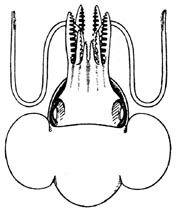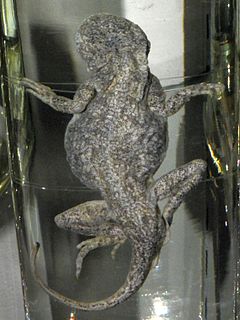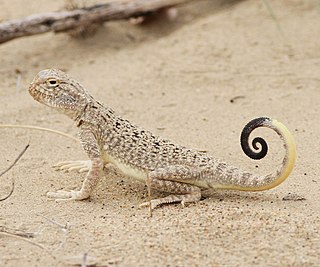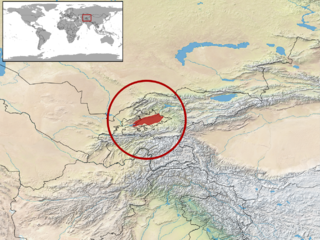
Phrynocephalus is a genus which includes 34 species of small and medium-sized agamid lizards, commonly called toadhead agamas or toad-headed agamas, that inhabit open arid and semiarid environments of Asia and Eastern Europe. The systematics of this genus are very complicated with many controversial points of view about the unclear phylogeny of this group. All representatives of this genus have adopted the so-called "sit and wait" hunting strategy and they actively use visual orientation when watching for food. In general, the ecological niche and role of Phrynocephalus species in lizard communities of arid environments of Asia are poorly studied, but seem to be similar to that of Phrynosoma, Cophosaurus, Holbrookia, Uta, and Sceloporus in the New World, as well as Moloch in Australia.

Phrynocephalus luteoguttatus, the yellow-speckled toad-headed agama, is a species of agamid lizard found in Iran, Afghanistan, Pakistan (Baluchistan) and possibly in India.
The reticulated toad-headed agama is a species of agamid lizard found in Central Asia and West Asia.

Phrynocephalus theobaldi is a species of lizard in the family Agamidae. The species is endemic to Asia.

The quagga catshark is a species of catshark, belonging to the family Scyliorhinidae. A small, slim-bodied shark reaching 37 cm (15 in) in length, it has a distinctive color pattern of narrow, dark brown vertical bars, which resemble those of the quagga. Its head is short and flattened, with a pointed snout tip that is not upturned.

Nectoteuthis pourtalesi is a bathybenthic species of bobtail squid native to the tropical western Atlantic Ocean, specifically Florida and the Antilles.
Austrorossia enigmatica is a species of bobtail squid native to the southeastern Atlantic Ocean; it occurs off the coast of southern Africa from Namibia to Cape Province. It lives at depths from 276 to 400 m.
The lappet-eared free-tailed bat is a species of bat in the family Molossidae. It is found in Benin, Burkina Faso, Democratic Republic of the Congo, Ivory Coast, Ghana, Guinea, Kenya, Liberia, Mali, Niger, Nigeria, Sudan, Tanzania, Togo, and Uganda. Its natural habitats are dry savanna and moist savanna. It is threatened by habitat loss.

Phrynocephalus persicus, commonly known as the Persian toad-headed agama, is a small diurnal desert lizard of the family Agamidae. It is the westernmost representative of the Central Asian genus of toad-headed agamas Phrynocephalus and is only known from deserts and semideserts of Iran and possibly Azerbaijan.

Phrynocephalus versicolor, the Tuvan toad-headed agama, is a species of agamid lizard found in desert areas of China and Mongolia. It was first described by the Russian herpetologist Alexander Strauch, director of the Zoological Museum at the Imperial Academy of Sciences at St. Petersburg.
Sagus Kul Lizard(Phrynocephalus erythrurus) is a species of agamid lizard endemic to China. This species is adapted to extremely high altitudes and can be found at elevation of 4500-5300m.
Forsyth's Toadhead Agama, is a species of agamid lizard endemic to China. This species was named after Sir T. Douglas Forsyth.

Phrynocephalus golubewii is a species of agamid lizard endemic to Turkmenistan.

Phrynocephalus guttatus, also known commonly as the spotted toadhead agama, the Saissan toad-headed agama, the Central Asian toadhead agama, and Salensky's toadhead agama, is a species of lizard in the family Agamidae. The species is native to southeastern Europe and western Asia. There are five recognized subspecies.

Phrynocephalus helioscopus, the sunwatcher toadhead agama, Fergana toad-headed agama, or sunwatcher, is a species of agamid lizard found in Kazakhstan, S Russia, Turkmenistan, Uzbekistan, Kyrgyzstan, Tajikistan, Turkey, Iraq, China, Mongolia, and Iran.

Przewalski's toadhead agama, also known as Tsarewsky's toadhead agama, or Steindachner's toadhead agama, is a species of agamid lizard found in China and Mongolia. This species was named after Nikolay Przhevalsky, a Russian Imperial geographer and explorer of Central and East Asia.
Phrynocephalus raddei is a species of agamid lizard found in Turkmenistan, Uzbekistan, Tajikistan, Iran, and Afghanistan.
Phrynocephalus rossikowi, the Uzbekistan toadhead agama, is a species of agamid lizard found in Turkmenistan and Uzbekistan.

Phrynocephalus strauchi, Strauch's toad agama, is a species of agamid lizard found in Tajikistan, Kyrgyzstan, and Uzbekistan.











